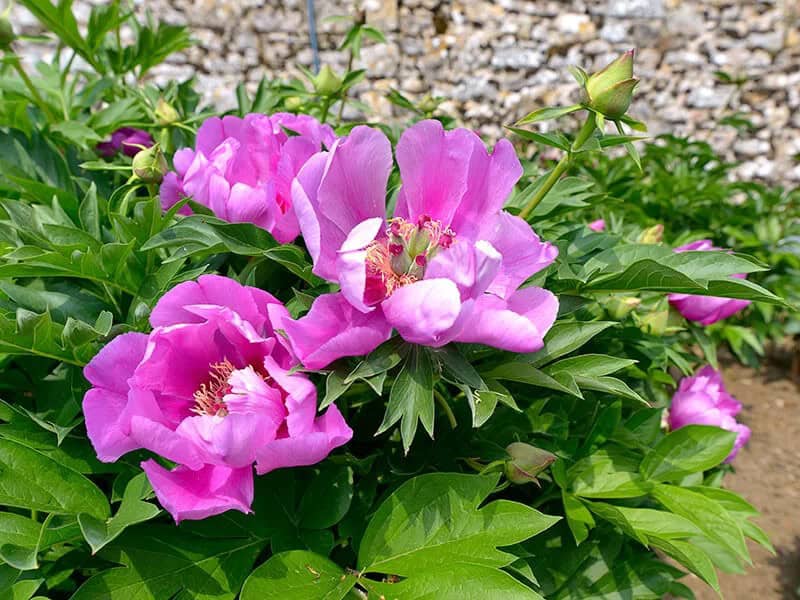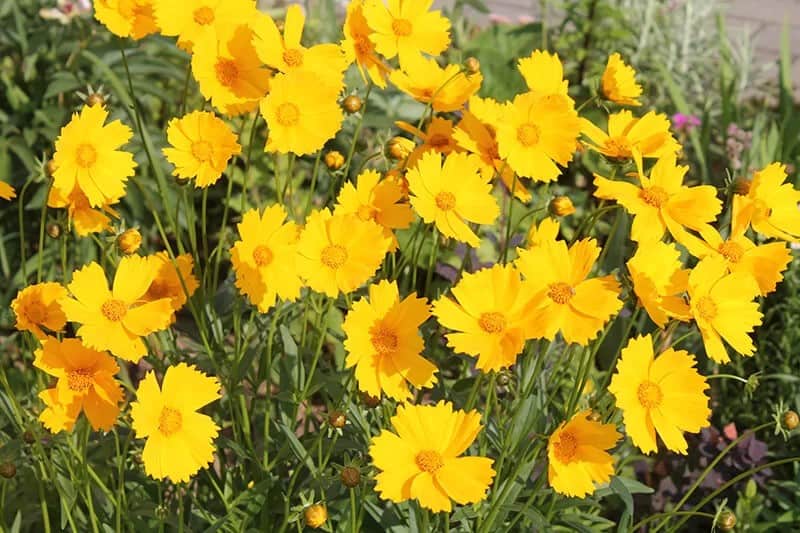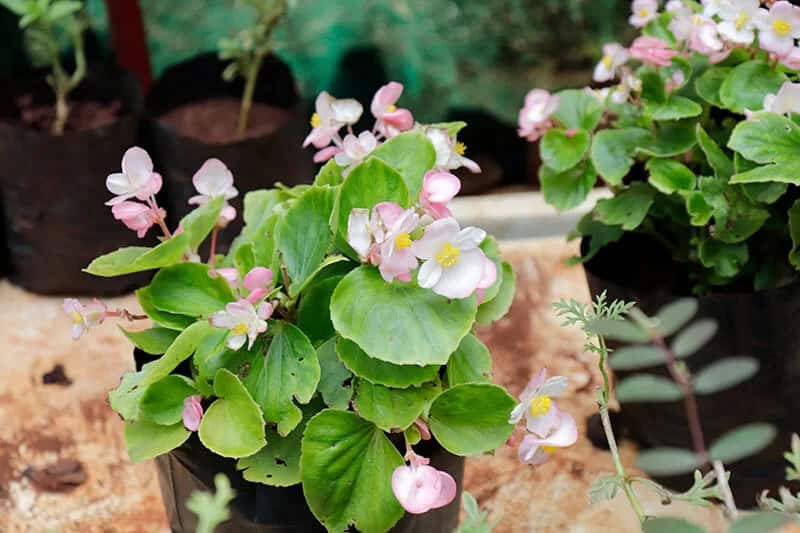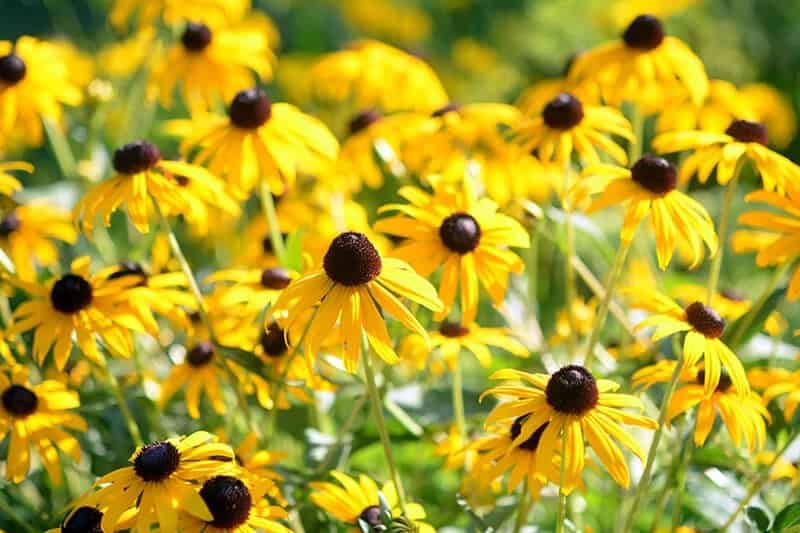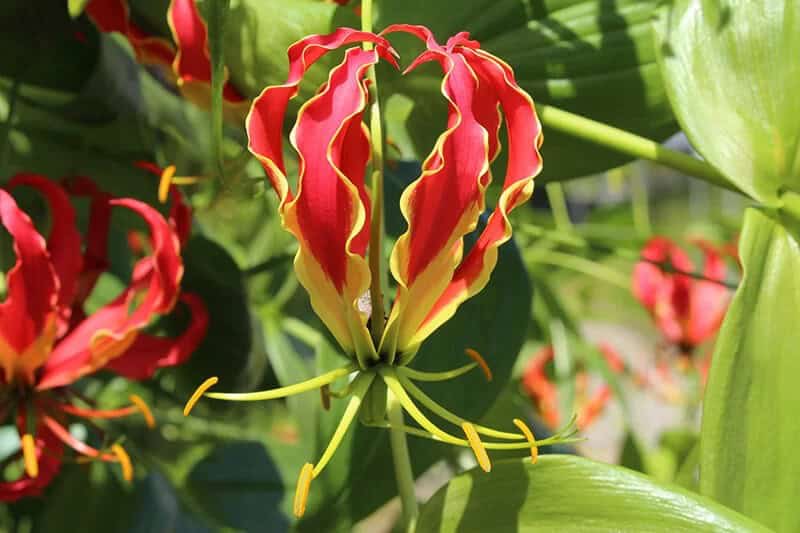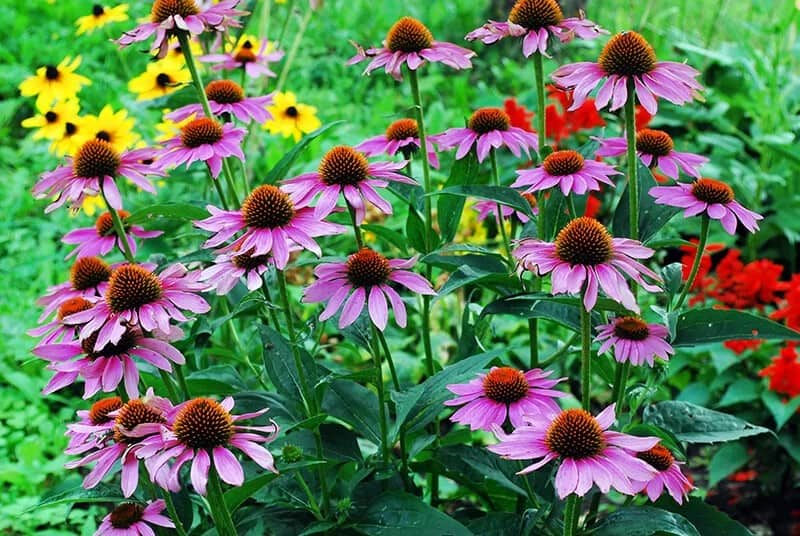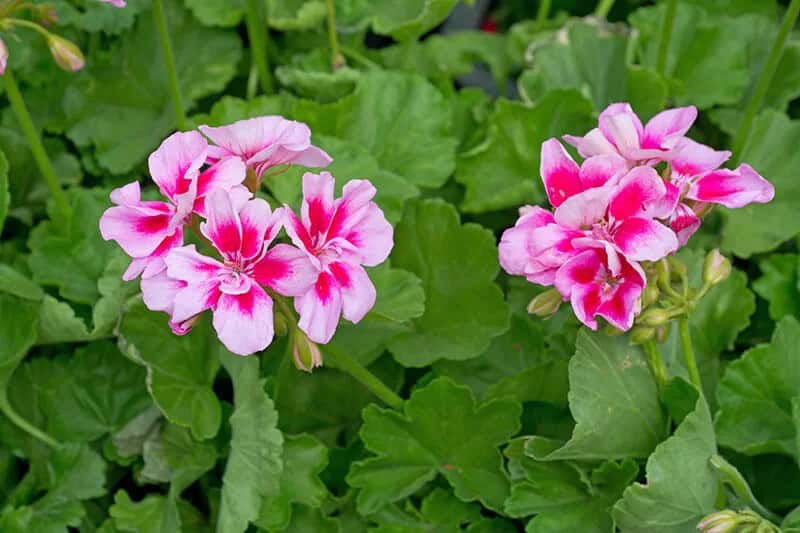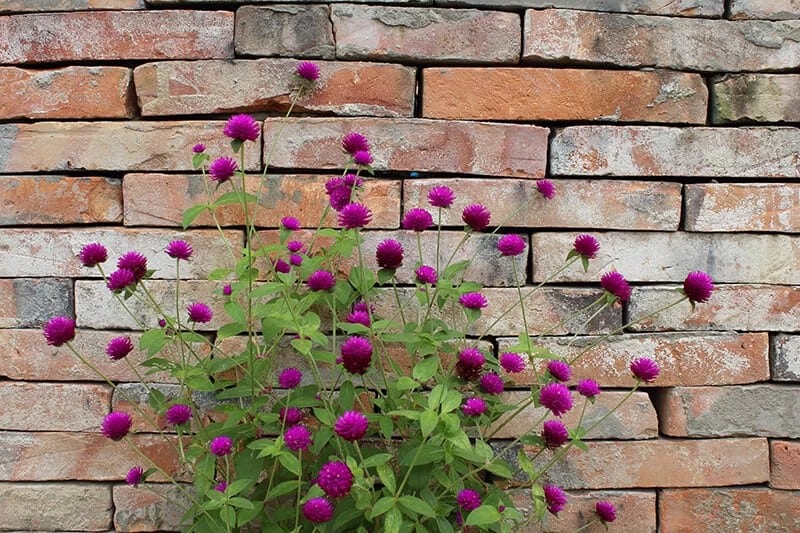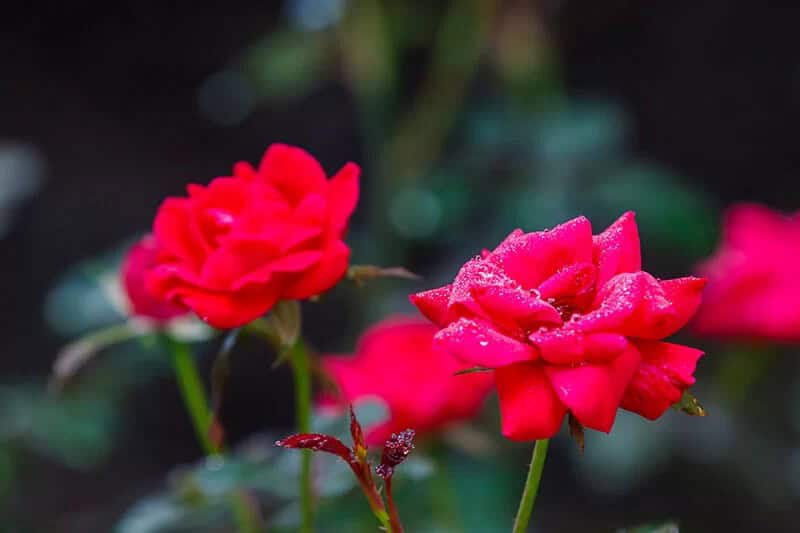Summer blooms bring a burst of vibrancy to any garden, with their diverse array of colors and textures. While annuals like impatiens and petunias are popular choices for adding a pop of color, perennials such as daylilies and coneflowers offer a unique charm that can be enjoyed year after year. Moreover, don’t overlook the ornamental value of foliage plants like coleus and sweet potato vine, which can add an equally stunning display of colors to your garden landscape.
27 Stunning Summer Flowers to Plant in Your Garden
Enliven your outdoor spaces with the vibrant colors of summer flowers! Whether you’re looking to add a splash of color to your porch or patio, or create a statement piece in your landscape design, these showstopping blooms are sure to impress. With their bold hues and unique shapes, summer flowers bring an injection of excitement to any garden setting. Plus, with the vast array of varieties available, you can craft a one-of-a-kind botanical masterpiece that reflects your personal style.
Sunflowers (Helianthus Annuus)
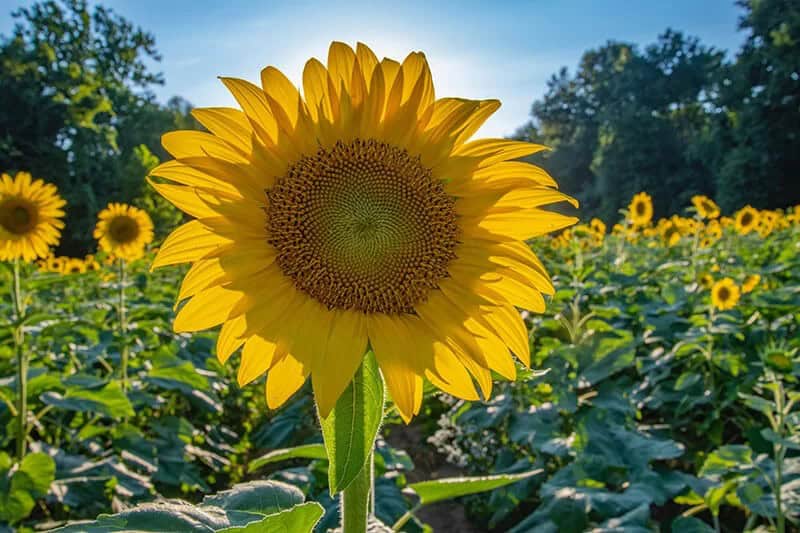
Susanne Jutzeler’s stunning photo, courtesy of pexels. com, perfectly captures the essence of sunflowers – a symbol of adoration, loyalty, and longevity. These vibrant annuals thrive in well-drained soil with a neutral pH, and their medium water needs are easily met. Growing zones 4 to 9 provide the ideal conditions for these full-sun lovers to flourish. As the days shorten, sunflowers burst forth into bloom during the summer into autumn seasons, producing an abundance of cut flower material.
To maximize blooms, be sure to plant them in full sun and deadhead spent flowers to encourage further flowering.
Zinnia (Zinnia Elegans)
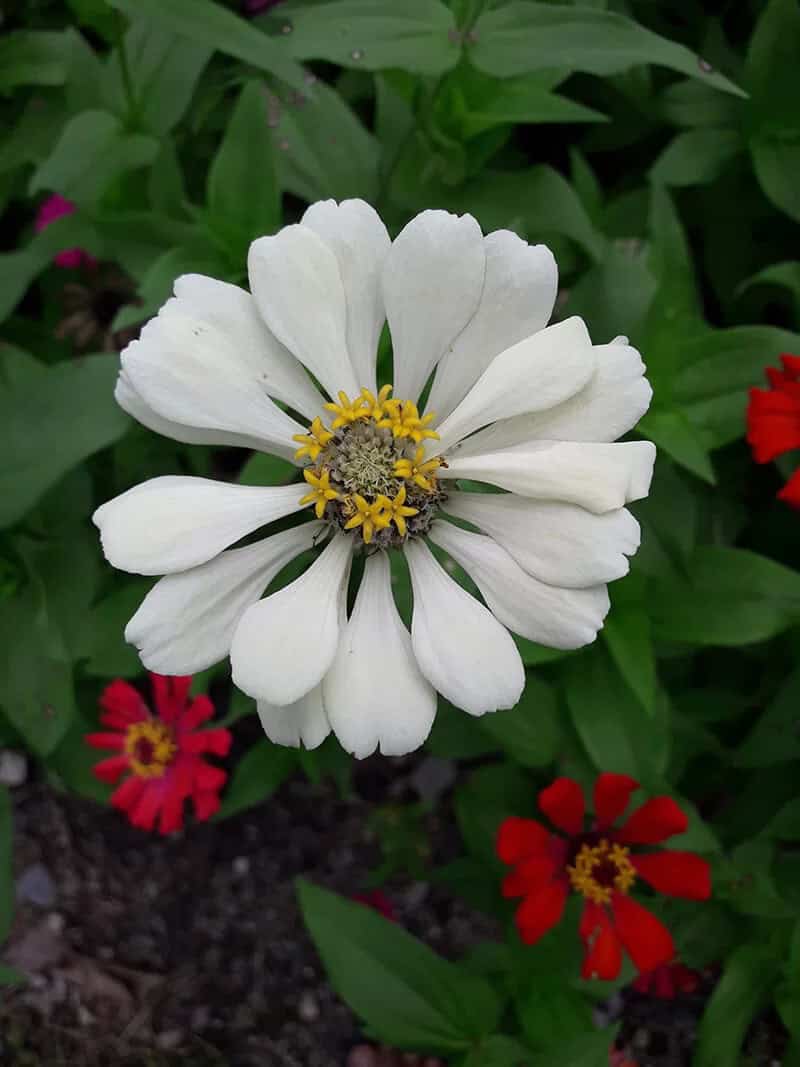
Zinnias are a popular choice among gardeners due to their stunning long-lasting flowers that come in an array of vibrant colors, including pink, orange, yellow, red, white, and purple. These annuals possess a unique symbolism, representing endurance, good thoughts, and lasting affection. When it comes to growing zinnias, they thrive in medium water conditions and well-drained soil. With a growing zone range of 3 to 10, zinnias are suitable for summer gardens across various regions.
Full sun is essential for optimal blooming, which typically occurs from summer until the onset of frost. Not only do zinnias make excellent cut flowers, but they’re also heat- and drought-tolerant, making them an ideal choice for summer gardens. Simply plant them in full sun with well-drained soil, and you’ll be rewarded with a bountiful display of colorful blooms.
Tropical Milkweed (Asclepias Curassavica)

Tropical milkweed, a stunning addition to any butterfly garden, exudes symbolism of hope, nurturance, and love. This vibrant plant requires medium watering and thrives in well-drained soil with a neutral pH. Its growing zones span from 8 to 11, making it an ideal choice for many regions. In terms of light, tropical milkweed can flourish in full sun but will also tolerate partial shade.
The showy clusters of orange and yellow flowers are not only a treat for the eyes but also attract bees, other insects, and hummingbirds. Moreover, this plant is the sole host for the unique Monarch butterfly in some areas, making it an essential nectar source. As the summer months transition into autumn, tropical milkweed blooms with its bright, cheerful flowers, perfect for capturing images of summer’s beauty.
Cosmos (Cosmos Bipinnatus)
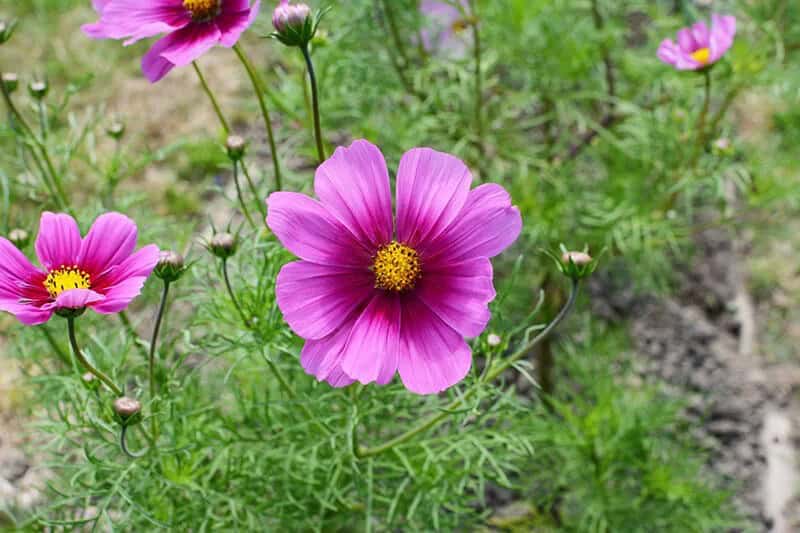
Cosmos, with its daisy-like blooms, is a timeless favorite in many gardens. As a symbol of peace and order, this annual flower has been delighting gardeners for centuries. Its medium water needs and preference for well-drained soil make it an accessible addition to any summer landscape. With a wide range of colors to choose from, including white, pink, purple, and red, cosmos is a versatile choice for adding a pop of color to your outdoor space.
As cut flowers, they’re also perfect for arrangements and bouquets. To bring out the best in these blooms, provide them with full sun and enjoy their beauty all summer long until the first frost.
Dahlia (Dahlia Hybrids)

The majestic dahlia flower is steeped in symbolism, representing dignity, creativity, and transformation. Its medium water requirements make it an ideal choice for gardens with moderate moisture levels. Well-drained soil is also essential for this beauty to thrive. As a warm-season crop, dahlias are perfect for USDA growing zones 8 to 11, where they can bask in full sun.
In fact, their blooming season typically runs from summer until the first frost, providing a vibrant splash of color throughout the warmer months. With an astonishing array of colors and sizes, it’s no wonder dahlias have become a popular choice for gardeners seeking a statement piece. Interestingly, these flowers originated in Mexico, where they were once used as a food source – tubers were eaten like potatoes!
Today, we cultivate dahlias for their stunning blooms, which can be enjoyed in both gardens and containers.
Gloriosa Daisy (Rudbeckia Gloriosa)

The Gloriosa Daisy is a timeless favorite in many gardens, and for good reason. Its vibrant yellow petals and warm brownish-red center create a cheerful presence that’s hard to resist. As a popular choice for bouquets, this daisy variety is a hit with bees and butterflies alike, capturing the essence of summer blooms with its sunny hue. But what really sets Gloriosa Daisies apart is their durability as perennials.
With proper care, they’ll return year after year, showering your garden with an abundance of bright yellow blooms. For those looking to bring a little sunshine into their outdoor spaces, the Gloriosa Daisy is an excellent choice.
Safflower (Carthamus Tinctorius)

The safflower, a plant with a rich history spanning thousands of years, has been a staple in many cultures. Its vibrant petals were once prized for their ability to produce a deep red dye, while the oil extracted from its seeds was used as lamp fuel. Today, the safflower continues to be cultivated for its oil, which is utilized in cosmetics and culinary applications alike. Moreover, this plant holds significant symbolic value, representing faithfulness to those who cultivate it.
Native to North America, the safflowers have also been employed as a food crop. Notably, their seeds remain a valued source of protein, with many still consuming them today.
Bougainvillea (Bougainvillea)
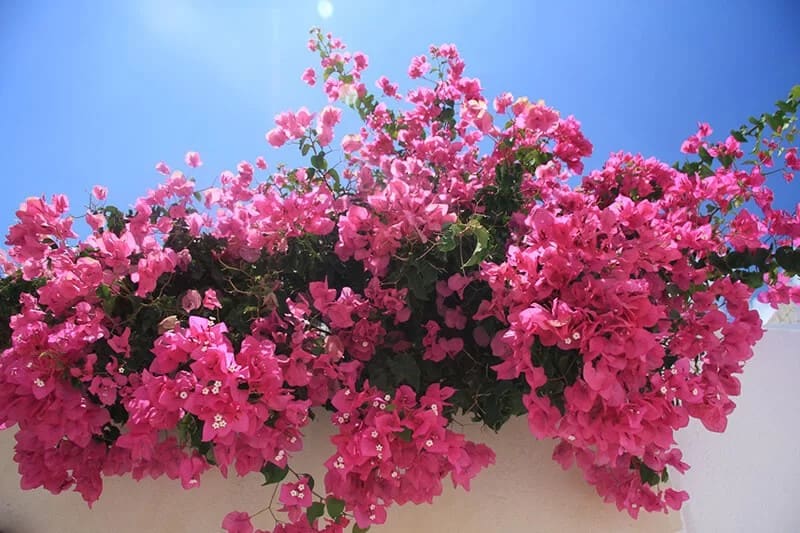
Bougainvillea, a vibrant and resilient flowering plant, brings unparalleled excitement to any garden. Its ability to thrive in full sun and high temperatures makes it an ideal choice for planting along foundations, trellises, or fences in warm climates. For those living in cooler areas, growing bougainvillea in containers allows for easy relocation indoors when the temperature drops at night.
Notably, this plant is renowned for its remarkable drought- and salt-tolerance, making it a prime selection for challenging spots in your yard. Among its many colors, white or ivory blooms stand out particularly against the plant’s dark green foliage.
Peony (Paeonia ‘Bowl of Cream’)
Fragrant and beautiful peonies are a staple in many gardens, boasting the unique ability to thrive for over 100 years as perennials. The classic bowl of cream peony’s creamy white petals and sweet fragrance can be attributed to its parentage, including the Chinese tree peony. While its light color may suggest vulnerability, this bush is surprisingly hardy and resistant to drought and deer.
One important consideration when growing this heirloom plant is patience, as it can take up to three years for a newly planted peony to bloom. A suitable environment for this plant includes medium to wet water needs, fertile and moisture-retentive soil, and full sun to part shade. It thrives in growing zones 3 to 8.
Marigold (Tagetes Erecta)
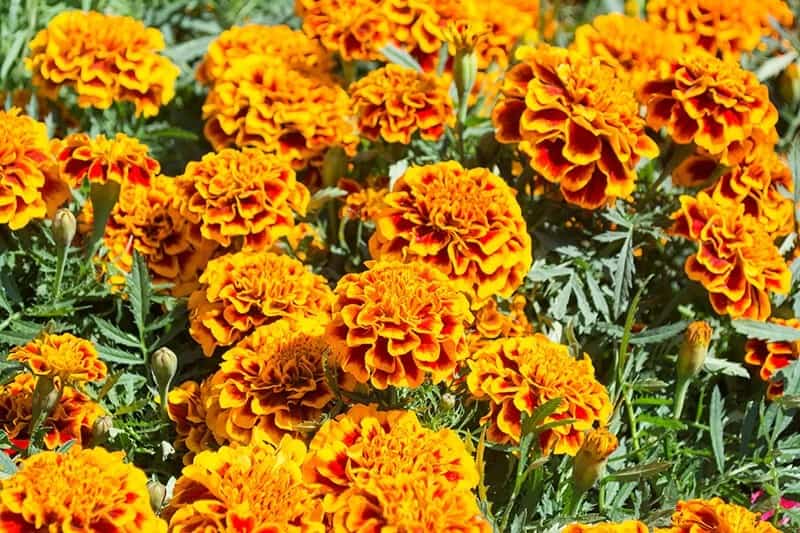
Marigolds are a reliable choice for any garden, boasting a range of benefits that make them a staple in many landscaping designs. With their ability to thrive in full sun and average, well-drained soil, they’re a low-maintenance option that still packs a punch. In terms of symbolism, marigolds are often associated with power and strength, making them a popular choice for gardens seeking to convey a sense of resilience.
In addition to their symbolic value, marigolds also have a practical edge – they require minimal care and can tolerate heat and drought conditions, ensuring a steady display of blooms throughout the summer into autumn. With over 50 different species to choose from, gardeners can select varieties that complement their existing plantings, creating a visually appealing and harmonious landscape.
As a bonus, marigolds have natural pest-repelling properties, making them an excellent choice for edging vegetable gardens or other areas where unwanted critters might be present. Overall, marigolds are a hardworking flower that can add a pop of color, a touch of symbolism, and a layer of protection to any garden.
Tickseed (Coreopsis)
Tickseed’s disk flowers are comprised of numerous smaller florets, characteristic of its sunflower family lineage. The ‘Sungold’ variety is particularly popular for its sunny demeanor, with deep golden yellow petals and a darker center. This drought-tolerant flower requires minimal care to bloom throughout the summer months, making it an attractive addition to any garden. Its cheerful appearance also attracts butterflies, bringing a splash of sunshine to your outdoor space.
As an added bonus, the edible seeds can be enjoyed in the fall.
Allium ‘Globemaster’ (Allium Giganteum)
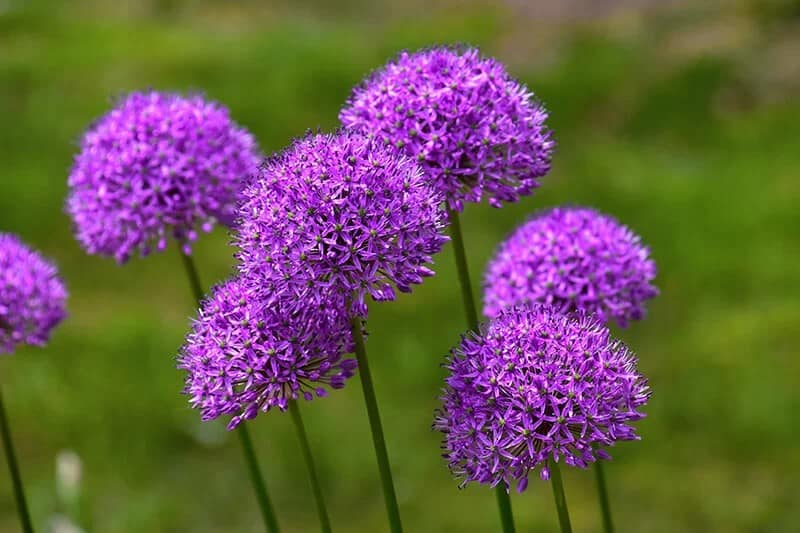
Ornamental onions are a versatile and striking addition to any garden, boasting dramatic 3-4 inch globe-shaped blooms that burst forth in early summer. Following the flowering period, the plant’s glossy green foliage remains, providing a captivating display of texture and interest throughout the fall season. The statuesque form of ‘Globemaster’ makes it an ideal focal point for mass plantings, while its unique appearance also lends itself well to container gardens.
With its low water needs, tolerance for full sun, and preference for moist, well-drained soil, this allium variety thrives in zones 5-9.
Begonia (Begonia Grandis)
A timeless classic, begonias have been delighting gardeners for centuries with their vibrant blooms and low-maintenance requirements. This particular variety, Begonia grandis, boasts showstopping flowers that can grow up to 4 inches wide, boasting ruffled petals in a range of pink, red, and white hues. While the striking blooms are undoubtedly the main attraction, the foliage is equally impressive, featuring giant leaves resembling elephant ears.
Thriving in medium water needs and rich, well-drained soil, Begonia grandis is an excellent choice for gardeners in USDA hardiness zones 8 to 11. As a shade-loving plant, it excels in part-shaded areas, where its summer blooms will continue until the first frost.
Black-Eyed Susans (Rudbeckia Hirta)
Black-eyed Susans (Rudbeckia hirta) radiate joy with their bright yellow petals adorned by a striking black or brown center. This vibrant flower is not only easy to cultivate but also thrives in a variety of conditions. With medium water needs, well-drained soil, and the ability to grow in zones 3 to 9, Black-eyed Susans can be found blooming in both spring and early fall.
Whether you’re seeking a low-maintenance addition to your garden or a vibrant cut flower arrangement, these cheery blooms are an excellent choice. As they often grow wild along roadsides and open fields, it’s no surprise that Black-eyed Susans have become a popular choice for those looking to add a pop of sunshine to their landscape, even in hot, dry areas where drought tolerance is crucial.
Flame Lily (Gloriosa Lily Superba)
The flame lily is an unmistakable showstopper in any garden, boasting climbed stems and vibrantly colored flowers that showcase its unique beauty. Its bold yellow petals with deep red tips are a striking feature, making it a genuinely magnificent plant to behold. The vines of the flame lily are covered in glossy green leaves, which provide the perfect backdrop for the large, bright flowers that bloom from mid-summer to fall.
Each flower features six petals that curl back from the center, revealing a burst of bright yellow stamens. As a tropical plant, it’s not frost-hardy and must be brought indoors or grown in a container in cooler climates.
Periwinkle (Vinca Minor)
Periwinkle is a shade-loving groundcover that’s perfect for solving problem areas in your garden. Its dense, spreading habit and deep green foliage make it ideal for filling gaps quickly. This low-maintenance option is also deer resistant, making it a great choice for gardeners of all levels. As an added bonus, periwinkle produces beautiful summer flowers in a range of colors including blue, lavender, pink, and white.
With its ability to thrive in full sun to partial shade and well-drained soil, this versatile groundcover can be grown in USDA zones 4-9. While it requires relatively low water needs, periwinkle is sure to add a pop of color and texture to any garden setting.
Coneflower (Echinacea)
The coneflower, native to North America, is a popular choice for butterfly gardens due to its striking blooms. The ‘Magnus’ variety boasts large petals that unfurl to reveal a distinctive brownish-orange center, perfectly complemented by magenta hues. This particular cultivar can grow up to 6 feet tall when in bloom, making it a dramatic addition to any garden. Its drought-tolerant nature also makes it an ideal choice for hot, dry summers, where it can thrive with minimal watering.
Furthermore, the coneflower requires medium water levels, average soil that tolerates poor drainage, and full sun to flourish.
Larkspur (Delphinium)
Larkspur’s delicate beauty is often overlooked, but its unique characteristics make it a standout in any garden or arrangement. The plant’s symbolism is rooted in levity and lightness, reflecting its airy, whimsical nature.
In terms of growing conditions, larkspur requires moderate watering, with soil that’s moist, well-drained, and rich in humus. It thrives in a range of climates, from USDA zones 2 to 10, making it a versatile addition to any outdoor space.
When it comes to light, larkspur prefers full sun to partial shade, ensuring its stems can reach their full height.
As the seasons change, larkspur blooms in shades of blue, pink, white, and purple, creating stunning displays that are perfect for fresh or dried arrangements. To preserve the flowers, cut the stems when they’re just beginning to open and hang them upside down in a cool, dark place.
The result is a beautiful, delicate bloom that’s both elegant and charming.
Whether you’re looking to add some whimsy to your garden or create stunning arrangements, larkspur is an excellent choice.
Geranium (Pelargonium)
The geranium, with its striking magenta flowers and delightful lemon-scented foliage, can bring a pop of color and fragrance to any garden. As a bonus, this variety boasts a long blooming season in the summer months. While it may require a bit more TLC than some other types of geraniums, it’s still relatively easy to cultivate, provided you offer it the right environment. This includes dry to medium levels of water, average soil that drains well, and full sun to partial shade.
Transvaal Daisy (Gerbera Jamesonii)
The Transvaal daisy is a vibrant flower that boasts a kaleidoscope of colors including yellow, orange, pink, red, and white. Each bloom can reach up to 5 inches in width and is borne on sturdy stems that stand at around 12 inches tall. Not only are the flowers stunning, but they also make excellent cut flowers. Another notable characteristic of this plant is its ability to bloom from late spring through summer and often into fall.
If you’re familiar with Gerbera jamesonii, you might know it by this name, or you may confuse it with the closely related garden gerbera (Gerbera jovis). The Transvaal daisy requires well-drained soil that’s rich in humus to thrive, and can tolerate full sun to partial shade. Its ideal growing zones range from 8 to 11. With a medium water requirement, this plant is relatively low-maintenance.
Globe Amaranth (Gomphrena Globosa)
The globe amaranth, a long-lasting cut flower, boasts vibrant colors in shades of pink, purple, red, white, and yellow. Its clustered, round blooms not only provide stunning visuals but also retain their beauty when dried, making them an excellent addition to dried flower arrangements. A fun and easy-to-grow annual, the globe amaranth thrives in hot, dry conditions, withstanding poor soil as long as it drains well.
With a growing range of zones 2-8, this versatile plant requires average sunlight, full sun being ideal. Blooming from summer until frost, the globe amaranth is an excellent choice for those seeking a low-maintenance yet visually striking addition to their garden.
Strawflower (Xerochrysum Bracteatum)
The symbolism surrounding strawflowers is deeply rooted in the concept of immortality. These stunning summer blooms boast papery petals that come in a kaleidoscope of colors, including yellow, pink, red, purple, and white. As they thrive in full sun and well-drained soil, strawflowers are perfect for dried arrangements due to their remarkable ability to retain their vibrant hues and delicate shapes.
To ensure optimal preservation, cut the stems when the blooms are just beginning to unfurl and hang them upside down in a cool, dark environment. Strawflowers can be grown in zones 9 to 11, requiring only dry to medium watering throughout.
Shoeblackplant (Hibiscus Rosa-sinensis)
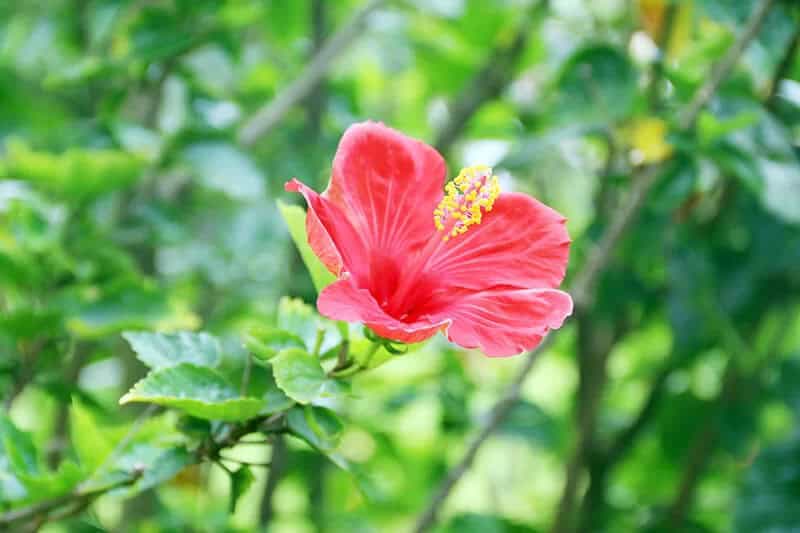
The tropical shoeblackplant, an evergreen beauty, boasts showy flowers that may only last a day but can reach up to 8 inches in diameter. The vibrant blooms typically feature a deep maroon red center that transitions to a ruby hue on the outer petals. This ornamental plant has been imbued with symbolism for centuries, representing love and passion. With well-drained soil that prefers organic matter and full sun to part shade light, shoeblackplant thrives in growing zones 10 to 12.
Fertilized with a balanced formula, it rewards gardeners with an abundance of flowers throughout the season, making it a stunning addition to any tropical landscape.
Rosa Radrazz (Rosa ‘Knock Out’)
The knock-out rose, a highly sought-after bush rose, boasts a robust growth pattern and an impressive floral display that persists from early spring to the onset of winter. Its adaptability to various soil types, including loamy soils, makes it a versatile addition to any garden. Moreover, this carefree red rose is renowned for its natural resistance to disease, making maintenance a breeze.
With full sun to partial shade and moderate watering needs that vary depending on climate, this rose thrives in USDA hardiness zones 5 through 9.
Lantana (Lantana Camara)
In harmony with nature, Lantana’s symbolism embodies unity and togetherness. As a medium water needs plant, it thrives in well-drained soil that can tolerate poor conditions. This adaptable beauty flourishes in growing zones 7 to 11, where it basks in full sun. Late spring through frost marks the beginning of its blooming season, which extends nearly year-round in warmer climates.
A popular choice for hanging baskets and container gardens, Lantana’s radiant blooms attract butterflies and hummingbirds. Its robust citrusy scent not only charms the senses but also repels deer and rabbits. When planted en masse, this low-maintenance groundcover creates a kaleidoscope of color that requires minimal upkeep.
Red Hot Poker (Kniphofia)
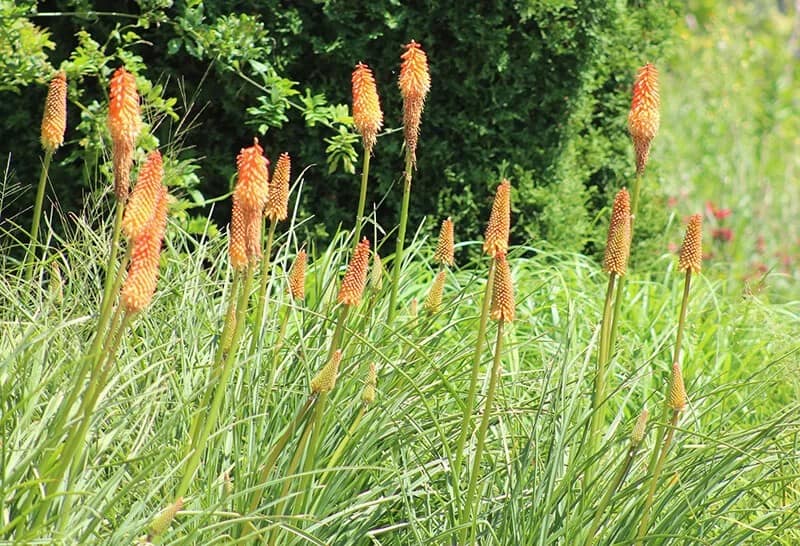
Red hot poker’s striking tubular flowers in shades of vibrant red are unmistakable in any garden setting. With its ability to thrive in well-drained soil and full sun to partial shade, this plant may seem like it requires a lot of maintenance, but surprisingly, it’s quite low-maintenance once established. In fact, it can even tolerate some drought. Its tall stature makes it perfect for the back of a border or as a solo statement piece.
With its growing zones ranging from 4 to 9, you can enjoy this showstopper in your garden all year round.
Scarlet Sage (Salvia Splendens)
Sage, a striking and versatile plant, boasts a range of symbolic meanings, from wisdom and healing to protection and clarity. With medium water needs and well-drained soil requirements, this beauty thrives in zones 5 to 8 and basks in the warmth of full sun. As the early summer blooms begin to unfurl, sage’s unique properties become even more apparent. Not only is it a popular choice for cooking, adding depth and complexity to various dishes, but its meanings extend beyond the kitchen.
Sage can be gifted as a symbol of good luck or incorporated into spells seeking protection. Its potency has earned it a reputation as one of the most powerful herbs around.
27 Perfect Summer Flowers to Brighten Up Your Garden
As the days shorten and temperatures cool, it’s a sign that summer is slowly coming to a close. But don’t let the end of the warmest season mean the demise of your garden. Instead, look forward to the warmer months ahead when you can bring vibrancy back into your outdoor space with a burst of colorful summer flowers. With an array of annuals and perennials to choose from, you can create a stunning display that will bloom throughout the entire summer season.
Consider incorporating some of these gorgeous blooms into your garden this year and get ready to welcome the sunshine back with open arms.
